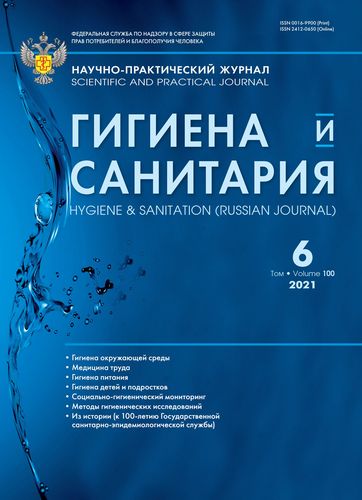Gas chromatography/tandem mass spectrometry with long-term alkaline transesterification for the determination of esters of monochloropropanediols and glycidol with fatty acids in edible vegetable oils and fats
- 作者: Makarenko M.A.1, Malinkin A.D.1, Bessonov V.V.1
-
隶属关系:
- Federal Research Centre of Nutrition and Biotechnology
- 期: 卷 100, 编号 6 (2021)
- 页面: 640-646
- 栏目: METHODS OF HYGIENIC AND EXPERIMENTAL INVESTIGATIONS
- ##submission.datePublished##: 14.07.2021
- URL: https://bulletin.ssaa.ru/0016-9900/article/view/639311
- DOI: https://doi.org/10.47470/0016-9900-2021-100-6-640-646
- ID: 639311
如何引用文章
全文:
详细
Introduction. The article discusses the method of determination of 2-, 3-monochloropropanediol (2-MCPDE, 3-MCPDE) and glycidyl (GE) fatty acids esters in edible vegetable oils and fats by slow alkaline transesterification and GC-MS/MS. Many toxicological data showed these substances to have the potential for human health risks if consumed; in addition, existing determination methods have various limitations. So, there is a need to expand the variety of 2-MCPDE, 3-MCPDE and GE determination methods.
Materials and methods. 2- and 3-MCPD esters, and glycidyl esters in their corresponding free forms were measured by slow alkaline transesterification with GC-MS/MS.
Results. Multiple reactions monitoring mode parameters were optimized. Compared to SIM operating mode, MRM mode improved the selectivity and increased the signal-to-noise ratio. The method was linear in the range of 0.3 mg/kg - 30.0 mg/kg for each analyte. Recovery, tested in this range, was found to be 87.5%-113.6 %.
Conclusion. The method discussed here was based on the ISO 18363-2: 2018 standard. In contrast to the last one, we used tandem chromatography-mass spectrometry to detect analytes and a method of absolute calibration with internal standards to quantitate them. In addition, it is proposed to analyze a spiked sample during the sequence of unknown samples to improve the quality of results.
作者简介
Mariia Makarenko
Federal Research Centre of Nutrition and Biotechnology
编辑信件的主要联系方式.
Email: dragon.soul1992@ya.ru
ORCID iD: 0000-0003-1688-6304
MD, junior researcher in the laboratory of food chemistry, Federal Research Center of Nutrition and Biotechnology, Moscow,
109240, Russian Federation.
e-mail: dragon.soul1992@ya.ru
俄罗斯联邦Alexey Malinkin
Federal Research Centre of Nutrition and Biotechnology
Email: noemail@neicon.ru
ORCID iD: 0000-0002-0370-4500
俄罗斯联邦
Vladimir Bessonov
Federal Research Centre of Nutrition and Biotechnology
Email: noemail@neicon.ru
ORCID iD: 0000-0002-3587-5347
俄罗斯联邦
参考
- Risks for human health related to the presence of 3- and 2-monochloropropanediol (MCPD), and their fatty acid esters, and glycidyl fatty acid esters in food. EFSA J. 2016; 14(5): 4426. https://doi.org/10.2903/j.efsa.2016.4426
- Gao B., Li Y., Huang G., Yu L. Fatty Acid Esters of 3-Monochloropropanediol: A Review. Annu. Rev. Food Sci. Technol. 2019; 10(1): 259–84. https://doi.org/10.1146/annurev-food-032818-121245
- Tiong S.H., Saparin N., Teh H.F., Ng T.L.M., Zain M.Z.B., Neoh B.K., et al. Natural organochlorines as precursors of 3-monochloropropanediol esters in vegetable oils. J. Agric. Food Chem. 2018; 66(4): 999–1007. https://doi.org/10.1021/acs.jafc.7b04995
- Hrncirik K., van Duijn G. An initial study on the formation of 3‐MCPD esters during oil refining. Eur. J. Lipid Sci. Technol. 2011; 113: 374–9. https://doi.org/10.1002/ejlt.201000317
- Weißhaar R., Perz R. Fatty acid esters of glycidol in refined fats and oils. Eur. J. Lipid Sci. Technol. 2010; 112: 158–65. https://doi.org/10.1002/ejlt.200900137
- Jędrkiewicz R., Kupska M., Głowacz A., Gromadzka J., Namieśnik J. 3-MCPD: A worldwide problem of food chemistry. Crit. Rev. Food. Sci. Nutr. 2016; 56(14): 2268–77. https://doi.org/10.1080/10408398.2013.829414
- EFSA Panel on Contaminants in the Food Chain (CONTAM), Knutsen H.K., Alexander J., Barregård L., Bignami M., Brüschweiler B., Ceccatelli S., et al. Update of the risk assessment on 3-monochloropropane diol and its fatty acid esters. EFSA J. 2018; 16(1): 5083. https://doi.org/10.2903/j.efsa.2018.5083
- Schultrich K., Frenzel F., Oberemm A., Buhrke T., Braeuning A., Lampen A. Comparative proteomic analysis of 2-MCPD- and 3-MCPD-induced heart toxicity in the rat. Arch. Toxicol. 2017; 91(9): 3145–55. https://doi.org/10.1007/s00204-016-1927-0
- Appel K.E., Abraham K., Berger-Preiss E., Hansen T., Apel E., Schuchardt S., et al. Relative oral bioavailability of glycidol from glycidyl fatty acid esters in rats. Arch. Toxicol. 2013; 87(9): 1649–59. https://doi.org/10.1007/s00204-013-1061-1
- Makarenko M.A., Malinkin A.D., Bokov D.O., Bessonov V.V. Monochloropropanediols, glycidol and their esters in children food. Voprosy detskoy dietologii. 2019; 17(1): 38–48. https://doi.org/10.20953/1727-5784-2019-1-38-48 (in Russian)
- Zelinkova Z., Giri A., Wenzl T. Assessment of critical steps of a GC/MS based indirect analytical method for the determination of fatty acid esters of monochloropropanediols (MCPDEs) and of glycidol (GEs). Food Control. 2017; 77: 65–75. https://doi.org/10.1016/j.foodcont.2017.01.024
- Crews C., Chiodini A., Granvogl M., Hamlet C., Hrnčiřík K., Kuhlmann J., et al. Analytical approaches for MCPD esters and glycidyl esters in food and biological samples: A review and future perspectives. Food Addit. Contam., Part A. 2012; 30(1): 11–45. https://doi.org/10.1080/19440049.2012.720385
- Kuhlmann J. Determination of bound 2,3‐epoxy‐1‐propanol (glycidol) and bound monochloropropanediol (MCPD) in refined oils. Eur. J. Lipid Sci. Technol. 2011; 113: 335–44. https://doi.org/10.1002/ejlt.201000313
- Weißhaar R. Determination of total 3‐chloropropane‐1,2‐diol (3‐MCPD) in edible oils by cleavage of MCPD esters with sodium methoxide. Eur. J. Lipid Sci. Technol. 2008; 110: 183–6. https://doi.org/10.1002/ejlt.200700197
- Goh K.M., Wong Y.H., Ang M.Y., Yeo S.C.M., Abas F., Lai O.M., et al. Comparison assessment between SIM and MRM mode in the analysis of 3-MCPD ester, 2-MCPD ester and glycidyl ester. Food Res. Int. 2019; 121: 553–60. https://doi.org/10.1016/j.foodres.2018.12.013
补充文件







